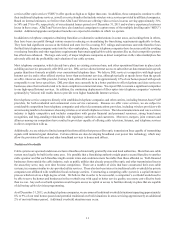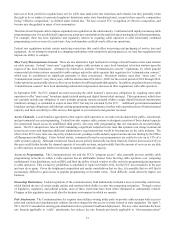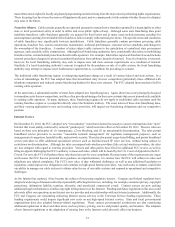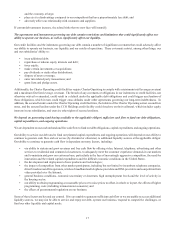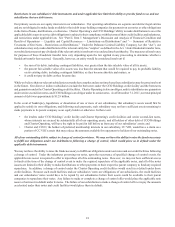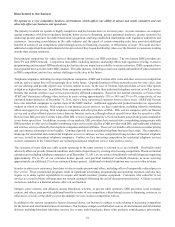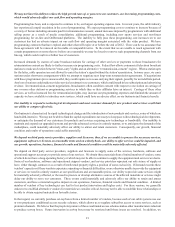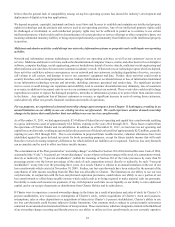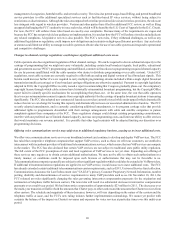Charter 2011 Annual Report Download - page 32
Download and view the complete annual report
Please find page 32 of the 2011 Charter annual report below. You can navigate through the pages in the report by either clicking on the pages listed below, or by using the keyword search tool below to find specific information within the annual report.20
and the Internet. Further, due to consumer electronic innovations, content owners are allowing consumers to watch Internet-
delivered content on televisions, personal computers, tablets, gaming boxes connected to televisions and mobile devices, some
without charging a fee to access the content. Technological advancements, such as video-on-demand, new video formats, and
Internet streaming and downloading, have increased the number of entertainment and information delivery choices available to
consumers, and intensified the challenges posed by audience fragmentation. The increasing number of choices available to audiences
could also negatively impact advertisers’ willingness to purchase advertising from us, as well as the price they are willing to pay
for advertising. If we do not respond appropriately to further increases in the leisure and entertainment choices available to
consumers, our competitive position could deteriorate, and our financial results could suffer.
Our services may not allow us to compete effectively. Additionally, as we expand our offerings to introduce new and enhanced
services, we will be subject to competition from other providers of the services we offer. Competition may reduce our expected
growth of future cash flows which may contribute to future impairments of our franchises and goodwill.
Economic conditions in the United States may adversely impact the growth of our business.
We believe that continued competition and the weakened economic conditions in the United States, including the housing market
and relatively high unemployment levels, have adversely affected consumer demand for our services, particularly basic video.
These conditions combined with our disciplined customer acquisition strategy contributed to video revenues declining 2% for the
year ended December 31, 2011 compared to the corresponding period in 2010, while we continued to grow our commercial, Internet
and telephone businesses. We believe competition from wireless and economic factors have contributed to an increase in the
number of homes that replace their traditional telephone service with wireless service thereby impacting the growth of our telephone
business. If these conditions do not improve, we believe the growth of our business and results of operations will be further
adversely affected which may contribute to future impairments of our franchises and goodwill.
We face risks inherent in our commercial business.
We may encounter unforeseen difficulties as we increase the scale of our service offerings to businesses. We sell Internet access,
data networking and fiber connectivity to cellular towers and office buildings, video and business telephone services to businesses
and have increased our focus on growing this business. In order to grow our commercial business, we expect to increase expenditures
on technology, equipment and personnel focused on the commercial business. Commercial business customers often require
service level agreements and generally have heightened customer expectations for reliability of services. If our efforts to build
the infrastructure to scale the commercial business are not successful, the growth of our commercial services business would be
limited. We depend on interconnection and related services provided by certain third parties for the growth of our commercial
business. As a result, our ability to implement changes as the services grow may be limited. If we are unable to meet these service
level requirements or expectations, our commercial business could be adversely affected. Finally, we expect advances in
communications technology, as well as changes in the marketplace and the regulatory and legislative environment. Consequently,
we are unable to predict the effect that ongoing or future developments in these areas might have on our telephone and commercial
businesses and operations.
Our exposure to the credit risks of our customers, vendors and third parties could adversely affect our cash flow, results of
operations and financial condition.
We are exposed to risks associated with the potential financial instability of our customers, many of whom have been adversely
affected by the general economic downturn. Dramatic declines in the housing market, including falling home prices and increasing
foreclosures, together with significant increases in unemployment, have severely affected consumer confidence and caused
increased delinquencies or cancellations by our customers or lead to unfavorable changes in the mix of products purchased. These
events have adversely affected, and may continue to adversely affect our cash flow, results of operations and financial condition.
In addition, we are susceptible to risks associated with the potential financial instability of the vendors and third parties on which
we rely to provide products and services or to which we outsource certain functions. The same economic conditions that may
affect our customers, as well as volatility and disruption in the capital and credit markets, also could adversely affect vendors and
third parties and lead to significant increases in prices, reduction in output or the bankruptcy of our vendors or third parties upon
which we rely. Any interruption in the services provided by our vendors or by third parties could adversely affect our cash flow,
results of operation and financial condition.



